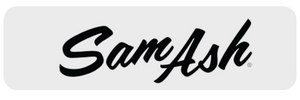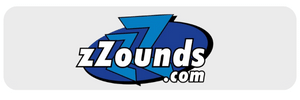This is my Boss Nextone Special Review.
Is there still a future for tube amps? Or are transistor amps with Tube emulation taking over? The Boss Nextone Special takes a big step toward a new world dominated by transistors. It is a beautiful, robust amp that is ready to deliver, in the studio or live. The Boss Nextone Special has virtually infinite tonal possibilities and a full suite of necessary effects inside. It feels like an amp for professional players. Perhaps that’s why, only downside, a foot controller is not included.
Let’s check out this amplifier!
Overview
The Next Level Solid State?
Roland has been a major player in the electric guitar market for many years. It is one of the great Japanese innovators of digital musical instruments. When you say Roland, you think of guitar synthesizers, the mythical solid-state Jazz Chorus and the Cue amps that have been around since the 1970s. And last but not least, what guitarist has never had a Boss effects pedal under his or her feet?
A smart move by Roland is to use the Boss brand for guitar amps starting in 2016. The Katana series of digital modeling amplifiers has received numerous awards and marked another breakthrough. This was followed by the Waza Craft boutique amplifiers and the Nextone series, among others. The Nextone series demonstrated a new take on digital modeling and utilized Roland’s Tube Logic technology. This simulates the behavior of classic tube circuits down to the component level.
Especially for guitarists who like to create their own sounds, and in doing so are not afraid to dive deep into a circuit, the Nextone is a godsend. The Nextone has a true class AB output stage and a full suite of editing capabilities via the Nextone Editor app. The Boss Nextone Special takes that to an even higher level.
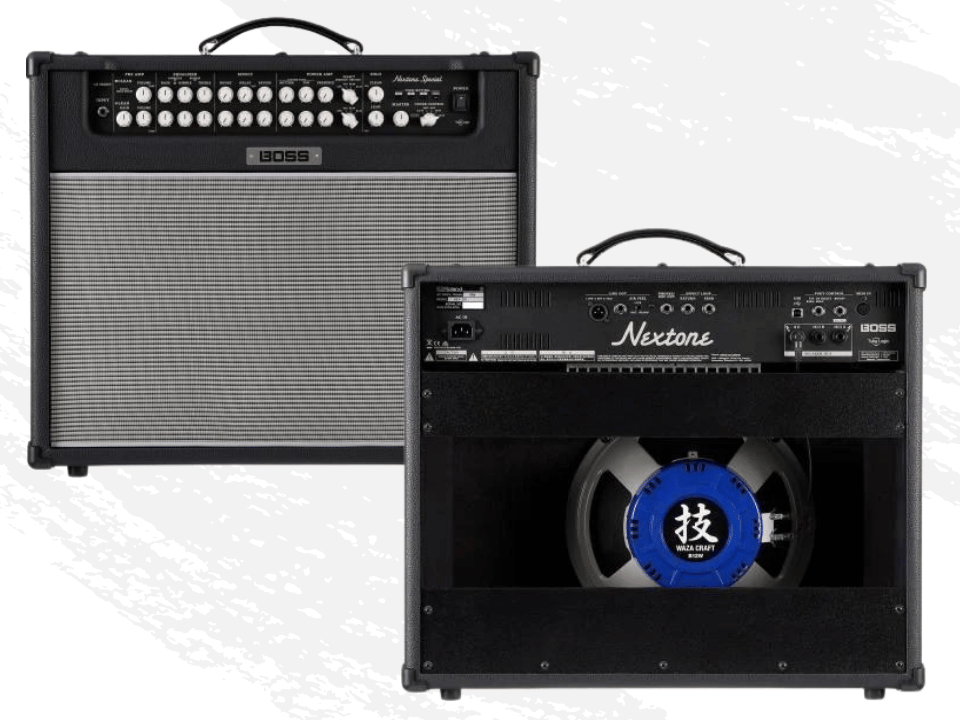
- Price indication: $ 950
- Speaker: 1 x 12″ Custom Waza B12W
- Power: 80W
- Weight: 39.7 lbs.
- Channels: 2
- Controls: Pre Amp, Equalizer, Effects, Power Amp, Solo. See below
- Connections: EQ (3-band), Effects Loop, MIDI I/O In, USB type B, Headphones 1/4 inch, Footswitch 1/4 inch

- Other: Dimensions (W x D x H): 24.5 inch x 9.7 inch x 20.9 inch, Footswitch not included. You need to buy the Boss GA-FC Footswitch separately.
For
- Easy to operate, lot of control
- Clean tones, selectable power tube simulation.
- High-quality vintage speaker powered by Tube Logic: replication of the organic essence of both vintage and modern high-end tube amps
Against
- Footswitch has to be purchased separately (recommended for live performers).
Check price:
Control panel and Connections
Boss Nextone Special Review
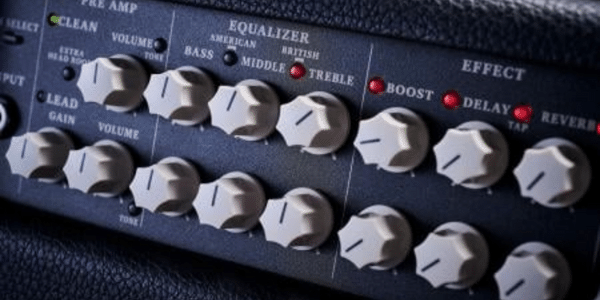
The Nextone Special has a beautiful vintage look. The plywood cabinet has a thick layer of black vinyl and a black and silver striped speaker cloth. The back contains a single 12-inch BW12 Waza Craft speaker. This sounds like the classic alnice “blue bell” speakers of the 1960s.
The electronics within the steel chassis are more reminiscent of a computer than a guitar amp. The power supply and output stage are monitized on a large circuit board. Below that are cooling fins with imposing fins mounted, cooling the output stage transistors. We also see a large board for sound, and there are circuit boards for the front and rear panel controls.
Roland’s own ESC2 digital signal processor chip is the beating heart of the Nextone Special.
The control panel of the Nextone Special faces forward and includes two rows of ivory-gray controls for the clean and lead sounds. This amp has no shortage of knobs! There are no less than 24 rotary knobs and 10 push buttons. And that’s not counting the channel presets. In addition, we see 3 rotary switches. Fortunately, each knob is labeled. Enough to play with, and create your unique sounds. The real tone purists I recommend reading the manual to get the most out of the Nextone.
The two channels feature classic volume and tone controls, with an additional gain control for the lead channel. For each channel, the level can be gereld for the built-in boost, reverb and delay. The output stage has its own EQ and two selector switches. And there is a separate global EQ. The selector switches allow you to emulate 6v6, 6L6, EL84 and EL34 output stage tubes. The Nextone uses the so-called Tube Logic technology to do this. To suppress noise and hum, there are separate threshold and release controls.
On the right side of the amp we find separate controls for the solo volume of the clean and lead channels, a master volume and a selector switch to control the power of the output stage of the Nextrone Special. Here you can switch from the maximum of 80 watts to 60, 40, 20 or 0.5 watts, and to standby.
The back of the panel features several speaker outputs, a send and return jack for the effects loop, a headphone/recording output and a separate, balanced line output with a cabinet IR switch. There is also a usb b jack for direct recording and access to the amp for the Nextone Editor. Finally, there are connections for footswitches and a midi in.
Setting Up Your Unique Tones
Of course, there’s all sorts of things you can set via the controls on the front of the amp, but the Nextone Editor app gives the best access to all the options. For example, the app includes a more comprehensive EQ than the three-band EQ on the control panel. In the app, the EQ is four-part, with shelving bass and treble and dual parametric mdden control. This includes rgel controls for frequency, level and Q. You can also opt for a 10-band graphic EQ. Thereby, you can place the EZ before or after the preamp, or both.
The clean and lead channels contain several tone switches. For the clean channel, you can choose from fixed or variable value for the Bright option. The lead channel contains two fat options, both of which have controls for fixed or variable value.
The Boss Nextone Special has numerous effects, which you can’t immediately see when you go off the control panel. For example, there are no less than eleven types of boost. Think of a clean with a raw edge to a fat metal drive with compression. There are also several types of delay, from analog to tape echo to a tremolo with speed-depth and LFO shapes, to a simulation of Roland’s legendary SDE-3000. The same goes for the digital reverb. Here you can choose from plate, spring, or hall models with time, pre-delay, and separate EQ.
You can configure the effect loop to your liking: in series, parallel, and pre or post reverb. Of course, there is also a send and return control. And then there are additional functions such as bias and “sag” at the output stage. They each have their own controls, and global input level and EQ options can be found, as mentioned above. The Editor has a hundred user memory locations where you can store all your settings, and the amp has room for three patches. And there is a live WYSIWYg option for storing functions not on the control panel.
The Editor app has a well-thought-out design and is quick and easy to use. You do have to connect it via USB and can’t control it wirelessly (yet).
Amp Sounds
Boss Nextone Special Review
Without doing much about it, the Nextone Special’s clean sounds a bit like a Fender amp. The sound is nice and high, with a slightly hollow middle and a tight low. The lead channel is reminiscent of a souped-up tweed Champ or Deluxe, with a powerful middle. Through the realistic output stage simulations and extensive EQ controls, you can produce just about any amp sound imaginable. For example, you switch super fast from a bluesy 6v6 tweed sound to a monstrous EL34 metal sound, with accompanying stadium delay and reverb.
The Waza Craft speaker is great and retains its crisp highs and tight mids even at very high volumes. At 80 watts, this amp is absolutely loud enough for an average pub without a PA. The power switch offers the ability to change power in the process.
Customer Reviews – Boss Nextone Special
I don’t write many reviews, but this amp is something, uh…special. I recently sold a bunch of tube amps and use modelers at church to accommodate our silent stage setup. I have a large collection of various guitars, and I wanted one amp for home, and possibly for gigging, that was versatile, sounded great, was a credible replacement for my previous tube amps, and was reasonably easy to use.
I was drawn to the Nextone Special because of all of the front panel knobs. While that got me 80% where I wanted to be, the excellent computer-based application editor got me pretty close to 100% happy.
My go-to tones are Marshall-based, Fender-based, Vox-based, and, occasionally, Mesa Boogie-based. And yes, they are ALL in here, yet with some surprises. One of the most magical elements to this amp is the power section. Not only are the power tube emulations very credible, but the bottom and top adjustments (high pass and low pass respectively) make the difference in taking great tones from the preamp section and making them almost perfect.
Low end a little flubby? Then bring up the bottom control to tighten things up. Top-end a little too raspy? Just increase the top control and its smooth sailing. Using these controls is easy and super-effective…and all recallable from the presets. Marshall tones are relatively easy to dial in, and the key is in the bottom and top controls in the power section as mentioned above (using EL34 emulation of course). Vox is also relatively easy to get to with…
I have this amp. I play this amp. The number and feature set of the knobs make perfect sense for efficient and effective control of your sound. Two independent channels. That’s what I want and need. Other cheap amps give you 1 1/2 channels, which is frustrating. This is what I want, two independent channels. EL84, EL34, 6L6, 6V6 selectable per channel.
I can put my favorite settings in memory. I can select British or American tone stacks per channel. I can select 6L6 tubes on Channel 1 for Fender Harmonic Clean and I can select EL34 tubes on channel 2 for Sizzling Crunch. I can have Reverb & Delay set just right for the clean channel and I can set Reverb & Delay just right for the Overdrive Channel. I can set the power scaling in the sweet spot at 0.5w for bedroom practice or 80w for stage playing a full band with drums.
The amp is built solid. The Waza speaker is a super performer with rich harmonics, body, bloom and power. IR out for recording. FX loop. Everything can be controlled by the front panel in seconds. There is a great 6 button footswitch for instant changes. There is an editor app so if I want to go into great detail for settings on my computer with a big screen I can do that in my leisure time. This is a well thought out amp that I have been waiting for for years. I started using the Blues Cube Hot Class A/B amp years ago that sounds great. But it is a very limited one channel amp with minimal footswitch control.
I have tube amps but the Boss Nextone Special can be 4 different amps in one song. It can be a clean Fender, a crunch Marshall, a singing Mesa Boogie, a jangly Vox. The Special performs like a superstar. The price is fantastic too. Update-able, good looking, functional, reliable. The best amp I have ever used. Been playing on stage and in my bedroom for 50 years. This is the kind of amp I would get two of. This is the future of amplification. Energy efficient operation, not a hog, like a tube amp. Class A/B power. Not Class D like cheap digital amps.
I sensed this amp would suffice for playing live and recording. What an understatement! Using the editor software via usb allows infinite tone creativity, however this aspect is not for beginners.
Tone hounds, such as myself, will love the simple and intuitive software UI. I’ve been able to find the tones lurking in my head after spending quality time with the amazing tone shaping capabilities of this system. I’ve saved 3 presets (capable of more) that can be switched via the (not included) Boss GF-AC footswitch. This foot controller is a must to gain full functionality and capability.
Each preset is fully independent of the others and a solo volume is available for each preset as well delay, reverb and boost! All eq parameters are set in the editor. There are many deeper functions available such as Bias and Sag, compressor etc. in the editor, so get in there and find your tone. I have owned, Mesa Boogie, Fender, Fuchs, Morgan, Orange, and a plethora of other amps and I don’t miss any of them.
Boss Nextone Special – Alternatives
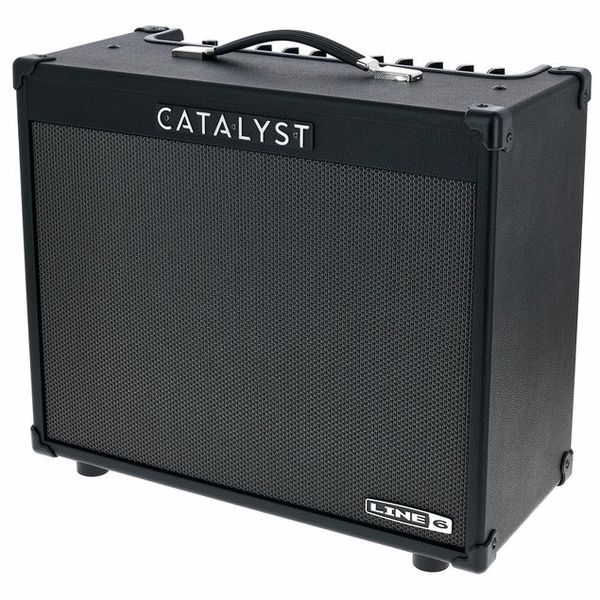
Line 6 Catalyst
The Line 6 Catalyst 100 is a dual-channel 1×12 combo amplifier that sounds and functions like a classic guitar amp while offering more versatility than a more recent amp. The 100-watt Catalyst 100 guitar amplifier sits in the middle of the Catalyst line of guitar amplifiers, which range in strength from 200 to 60 watts. It has studio-friendly features like a USB audio interface and is powerful enough for most performances.
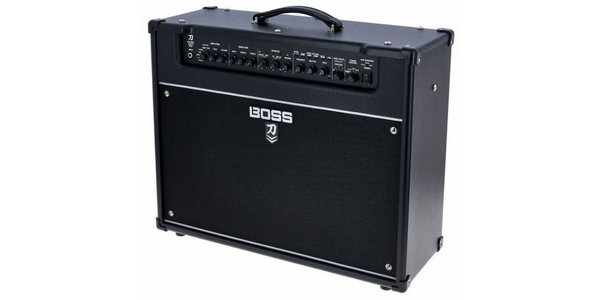
Boss Katana-Artist MkII
With cutting-edge features and versatility, the Katana-Artist MkII enhances the top model in the Katana family. Your tone options are doubled thanks to newly voiced variations for each of the five amp personalities, and the number of onboard effects categories has increased from three to five.
Additional sound-shaping choices are provided by exclusive front-panel controls, such as a three-way Contour switch, a Global EQ with three adjustable curves, and a Solo boost with adjustable volume. It’s also simple to link and operate two Katana-Artist MkIIs for powerful, ultra-wide tones thanks to the potent new dual amp capabilities.

Fender Mustang GTX100
Mustang GTX is a bolder guitar amp with unmatched features and performance. A variety of authentic and adaptable amp models, dozens of effects, and 200 onboard presets provide guitar tones for practically any genre. The clear full-color display shows what’s happening under the hood, while the modular signal path lets you move effects anywhere in the chain. Fender TONE 3.0, a free iOS and Android app, lets you spin the knobs and allows for deep editing,
Verdict – Boss Nextone Special
The Boss Nextone Special does everything it’s supposed to do, and even better! It is a true showpiece of Roland’s Tube Logic technology. A serious option for guitarists switching from tubes to transistors.
One possible drawback for some guitarists is that they may get a bit lost in the myriad options. The Nextone’s front panel is a busy affair with more than 30 knobs and switches, and there’s even more to control in the app. Boss could support those guitarists by placing a set of presets in a few available user slots. Those can then be overwritten by guitarists, but provide a good basis for getting started.
Perhaps that is precisely not done because this amp is intended for serious sound purists and tone controllers among the guitar crowd. For this target group, this amp offers absolute value for money. A side note is that no foot controller is included as standard. With all the options available, this is actually necessary. Now you have to buy the GA-FC footcontroller separately. Come on Roland, at least give customers who purchased this amp a hefty discount.
Boss Nextone Special

Check price:


